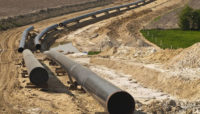Trump Order to Fast-Track Projects as Stimulus Shows Unclear Impact so Far

Federal agencies have produced little evidence that any infrastructure projects have been expedited under an executive order issued in early June by President Donald Trump, who cited need to speed up or even ignore environmental reviews in the "national emergency" caused by the COVID-19 pandemic's economic hit.
The directive is intended to boost approvals under federal law for transportation, energy and other projects to promote job growth and related investment, with compliance provisions in U.S. laws such as the National Environmental Policy Act (NEPA) bypassed on projects in emergency cases.
Under the order, the U.S. Transportation Dept. U.S. Army civil works units, U.S. Interior Dept. and others, were to have provided a list of expeditable projects by July 4 to the Office of Management and Budget (OMB) and to White House economic and environmental units, with work progress updates every 30 days "for the duration" of the COVID-19 "emergency."
Environmental advocacy group The Center for Biological Diversity released earlier this month an Interior Dept. July 15 list of 66 various infrastructure projects—from a highway upgrade and expansion in Maryland to a controversial LNG terminal and pipeline in Oregon—for which exemptions to provisions of NEPA and the Endangered Species Act are being considered.
Listed projects include the Mountain Valley natural gas pipeline in Virginia; Lake Powell water pipeline in Utah. and S. Route 58/220 Bypass to the North Carolina state line feasibility study.
Lots of Questions
The list is within a letter the group received from Deputy Interior Secretary Katherine S. MacGregor, in response to its July lawsuit filed after several agencies did not respond to Freedom of Information Act requests seeking similar lists of actions and decisions on projects in response to the order.
It is not clear whether other agencies have submitted lists or 30-day updates to OMB or White House units as required.
"The White House is trying to do whatever it can to fast-track projects, but whether it has succeeded is an unanswered question,” Center for Biological Diversity Government Affairs Director Brett Hartl told ENR. In an earlier statement, the group said it was concerned projects would be "rubber-stamped" without any environmental review.
A Washington insider who spoke on background, says the order only “gives agencies a nudge” without any additional authority to waive rules.
Interior’s list includes projects from various agencies that need NEPA and Endangered Species Act permits.
“Many project reviews are already on shorter schedules” from previous changes and the agency will examine those and others for additional expedited review, said MacGregor's letter to Larry Kudlow, director of the White House National Economic Council.
Heads of Interior Dept. agencies such as the Bureau of Land Management and U.S. Fish and Wildlife Service, as well as the U.S. Agriculture Dept.'s U.S. Forest Service told a Washington, D.C. federal court that they would alert the court on Oct. 16 when they will release relevant documents. The White House Council on Environmental Quality and OMB said they would file a joint status report to the court of documents received also on that date.
The Corps of Engineers, which awards Clean Water Act permits, has not yet responded to ENR’s request for a copy of its list. A Transportation Dept spokesman said the agency is reviewing an ENR request for its list and project status changes.
Hartl said the environmental group will keep pushing for documents, saying it released Interior’s project list to “sound the alarm” to states and others with links to or interest in project approvals.
States Have Concerns
After seeing the list, six of seven states that share Colorado River Basin water wrote to Interior Secretary David Bernhardt asking him to “refrain from issuing a final environmental impact statement or Record of Decision” for the Lake Powell water diversion pipeline to Utah until all affected states reach consensus on legal and operational concerns raised by the proposed project.
Without a consensus, the project, estimated to cost up to $1.9 billion, could face multiple years of litigation, the letter says.
In a separate request, Utah officials asked the Bureau of Reclamation to delay the EIS, which has been set for an expedited release in November, because of the volume of pro and con responses received during a comment period that ended Sept. 8 and the need for more analysis. The ROD, the final approval, has been set for early 2021 release.
Congress also is pushing agencies to release their lists.
The U.S. House Committees on Natural Resources, and Transportation and Infrastructure, and the Senate Committee on Environment and Public Works, as well as 54 members of Congress urged the White House to release the documents after Chase Jennings, OMB deputy director, said “these reports are not public.”
But the congressional representatives said in their request that “If the administration is confident that this executive order can legally and legitimately provide economic relief, it should disclose which projects and decisions it is advancing under the auspices of the order."
They asked for all reports submitted to the Council on Environmental Quality by any federal agency head to identify any planned or potential actions.
Ewelina Czapla, director of energy policy for the American Action Forum, a center-right policy institute, said in an opinion column that it is understandable for the administration to want to expedite infrastructure projects during the pandemic. “The outcome of its actions, however, may simply be more litigation and delays,” she said, noting that public interest groups have wondered how they can voice their concerns about projects secretly selected to skip such steps as notice and comment.
Meanwhile, the Council the Council on Environmental Quality issued a final rule in July to streamline NEPA reviews for infrastructure projects, and on Sept. 24 issued guidance on how to complete those reviews on projects during an emergency response.
“Alternative arrangements do not waive the requirement to comply with the statute, but establish an alternative means for NEPA compliance,” the guidance says.



